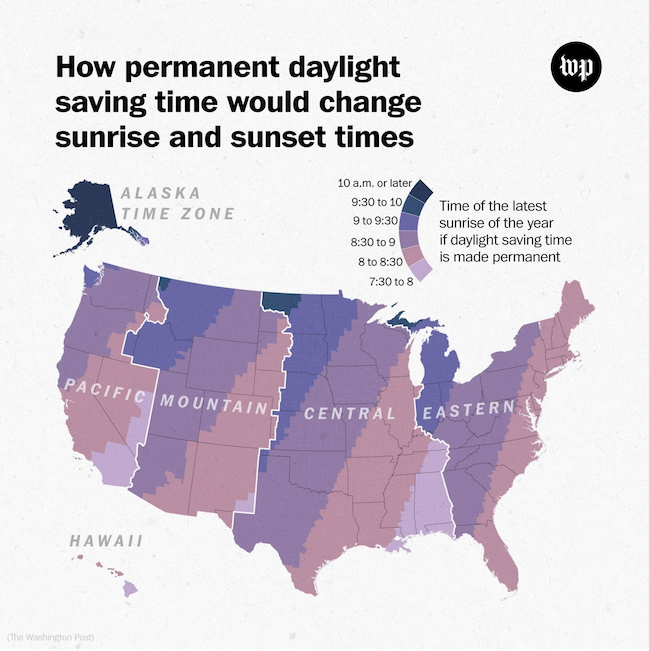It’s spring, and you know what that means: We’re officially in Daylight Savings territory.
If some people have their way, you might have to get used to this All. The. Time. Last week the US Senate unanimously passed the oddly named Sunshine Protection Act (does sunshine really need protecting?), which would make Daylight Savings Time permanent. The result would be later sunrises and later sunsets throughout the winter. No more changing the clocks twice a year, no more springing forward and falling back.
Here’s what sunrise and sunset would look like at various cities throughout the US:


No one disputes that changing the clocks twice a year is a bit of an inconvenience. Heck, whenever I have to change the clock in my car, it’s a royal pain in the ass. Plus a lot of people like it when it stays light later. They prefer driving home from work when it’s still light out.
So is this getting universal support?
Not exactly.
Personally, I’m a Standard Time person. I actually think it feels cozy when it gets dark early. I can put my jammies on early without feeling guilty. And as someone who gets up around 5AM, I don’t exactly relish the thought of the sun rising later than it already does.
I’m not alone. The American Academy of Sleep Medicine says that year-round standard time is better for our health, since it aligns better with human circadian biology and provides benefits for public health and safety. And a professor of biology at the University of Washington, Horacio del Iglesia, told The Seattle Times that year-round daylight saving time “would be like Monday morning every day for the rest of your life.” (Ugh.)
That’s not all. A 2019 AP-NORC Center for Public Affairs Research poll found that “4 in 10 Americans would like to see their clocks stay on standard time year-round, while about 3 in 10 prefer to stay on daylight saving time.”
What many people don’t realize is that year ’round DST has been tried before. During the oil crisis in the 1970’s, Daylight Savings Time was enacted in an effort to reduce energy consumption. It was scrapped after less than a year because parents were worried about the safety of their children, who were forced to go to school when it was still dark.
So what does this mean for skiers?
Because that’s what’s really important, isn’t it?
It kind of depends on where you’re located. Ski areas in Michigan, for example, would have it tough if the sun didn’t rise til 9 or 9:30, as indicated in the graphic above. In New England, which is on the eastern edge of the time zone, the sun would rise around 8AM — not too bad, but still fairly late, especially given that most lifts start turning at 8AM on weekends.
Then there’s the issue of opening the mountain. Lifts have to be inspected before they can load, and ski patrol needs to conduct safety checks and avalanche mitigation. Can these be done effectively in the dark? I don’t think so.
A solution would be for ski areas to adjust their operating hours. But that could mean it’d take longer for the ski areas to open, given everything that has to be done beforehand. It’d also get crowded earlier than it does right now, and traffic getting to the mountain could be worse. So there’s that, too.
Whether or not Daylight Savings Time becomes permanent is anyone’s guess. The legislation still needs to clear the House, and then get signed into law by President Biden.
I’m hoping it doesn’t. What about you?
